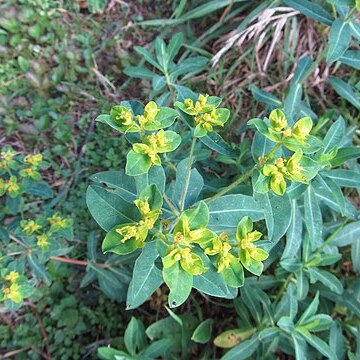Leaves subsessile; petiole c. 1 mm long, flattened, with a short tuft of hairs in the axil; lamina to 5–8 × 1–3 cm, linear-lanceolate to obovate or broadly obovate, obtuse to rounded at the apex and usually shortly apiculate, abruptly cuneate to rounded at the base, narrowly cartilaginous and sometimes ± revolute at the margin, glabrous.
Cyathia sessile, glabrous or occasionally sparsely pilose, c. 3.5 × 5.5 mm, with broadly cup-shaped involucres; glands 4–6, spreading, 1.5–3 mm broad, orbicular to transversely oblong, yellow; lobes 1 mm long, rounded, densely ciliate on the inner surface.
Perennial herb; rootstock thick woody, producing numerous simple or sparsely branched annual stems; stems erect to 60 cm high, or spreading and decumbent, 30–100 cm long, rarely more, glabrous or pilose with long spreading hairs.
Rootstock perennial, woody; stems 2 to several, herbaceous, or, if not burnt by fires, enduring for 2 or more years and becoming woody and leafless below simple or branched, 4 to 36 in. high
Bracts sessile, c. 1.5–2.5 × 1.5–3 cm, deltoid to suborbicular, longer below the umbel, apex obtuse to rounded, base with a tuft of hairs on the upper surface.
Cymes axillary and in (3)5(6)-branched umbels around a terminal bisexual cyathium, with primary rays to 7(10) cm long, each forking c. 3 times.
Capsule exserted on a pedicel to 6 mm long, c. 5 × 6.5 mm, shallowly 3-lobed, densely and strongly verrucose, usually tinged reddish.
Female flower: ovary densely verrucose, glabrous; styles 3 mm long, joined to nearly halfway, with spreading deeply bifid apices.
Seeds c. 2.5 × 2 mm, ovoid, slightly compressed, smooth, greyish-brown; caruncle 1 mm across.
Male flowers: bracteoles fan-shaped, densely ciliate; stamens 4.5 mm long.

